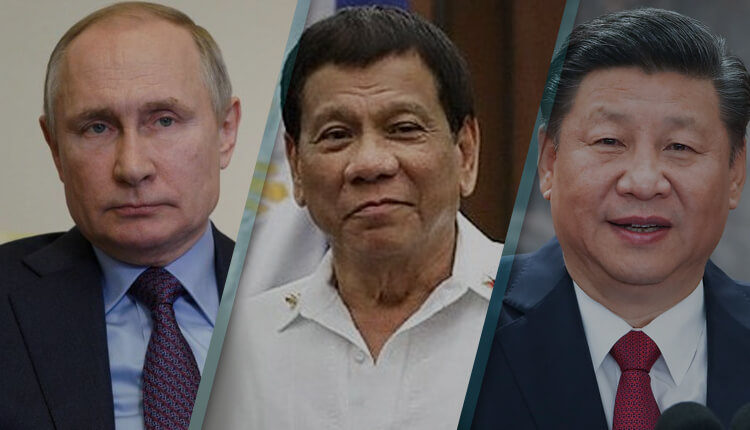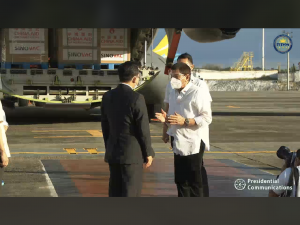China, Russian vaccines to sustain PH vaccination campaign
With US, EU guided by self-interest…

THE “independent foreign policy” of Pres. Duterte continues to benefit the country as both the European Union (EU) and the United States resorted to “vaccine nationalism” or barefaced “self-interest” in the use and allocation of global vaccine production exclusively for use of their respective citizens first.
Based on the presentation before the House Health Committee made by national vaccine czar, Secretary Carlito Galvez last March 30, 2021, it is clear the Philippines’s national vaccination campaign would be sustained by the supply coming from China and Russia in the coming days and in its aim of achieving a ‘vaccine security’ supply target of at least 140 million doses this year.
The country’s relationship with China and Russia had improved dramatically when Pres. Duterte was elected in 2016 and immediately moved to distance the country away from puppetry and subservience to US and EU imperialism, as practiced by his predecessors.
His decision was appreciated by both China and Russia which soon after aided the Philippines in many ways, such as in defeating the terrorist attacks in Marawi City in 2017 and in the country’s development efforts.
Pres. Duterte’s independent foreign policy where the country is “friend to all and enemy to no one,” also boosted respect for the country in the international community.
China and Russia to the rescue
According to Galvez, at the immediate, the country expects a steady supply of ‘Sinovac’ vaccines from China that already started last month at a rate of at least 1 million doses.
The supply is expected to rise further to 1.5 million in April, 2 million by May then rising to 4.5 million doses by June and another 3 million doses in July, under the government’s vaccine purchase program.

Last month, China helped in finally rolling out the country’s national vaccination program with a donation of 1 million doses that arrived last February 28. This is separate from the more than P500 million worth of donation consisting of PPEs, testing kits and other medical supplies last year that enabled the country to start its virus tracing program.
On the other hand, the first batch of Russian-made ‘Gamaleya’ (Sputnik 5) totaling 100,000 doses is expected to arrive this month of April before spiking to 2 million doses in May and to 4 million doses in June and July.
The above figures contrast to the vaccines to be provided by Big Pharma (read: EU/US) such as AstraZeneca and Moderna , whose deliveries can only be expected to come in by May, “but thi is subject to change,” Galvez stressed, referring to the hoarding policy by the EU and the US.
For May, AstraZeneca is expected to deliver 2.6 million doses, 2 million in June and another 2 million in July.
(However, AstraZeneca, like the vaccine created by US-based Pfizer, is now under close scrutiny over its reported deadly side effect, with “much of Europe still seeing increased AZ vaccine hesitancy,” Galvez said).
Moderna, for its part, can only deliver 194,000 doses in May and another 1 million doses in July; Johnson & Johnson for its part, can only deliver 1.5 million doses in July.
Another US-based supplier, ‘Novavax,’ can only deliver 1 million doses in June and another 2 million doses the following month.
From the above, it is very clear that without China and Russia’s support, the national vaccination schedule of the government would be in jeopardy.
According to Galvez, the government expects to ramp up its vaccination campaign starting this month and towards the month of May; for the month of April, the country’s vaccination campaign would have to rely solely from China, Russia and ‘Covax,’ the global vaccine supply program of the World Health Organization.
For May, the program would be again sustained by the combined 4 million doses deliveries from China and Russia and 1 million doses from Covax, compared to the 3.794 million doses from AstraZeneca and Moderna.
For the period June to July, the same pattern emerges, with the combined 9.5 million doses delivery from China and Russia in June compared to just 3 million doses from Big Pharma (AstraZeneca and Novavax).
It would only be in July that deliveries from the EU/US can decently compare to the commitments from Russia and China whose combined delivery is placed at 7 million doses.
On the other hand, the combined delivery from Big Pharma—Moderna, Novavax, J&J and AstraZeneca is expected at 6.5 million doses.
Overall, Galvez said the Philippines had already concluded negotiation with China’s Sinovac for the supply of 25 million doses and 15 million from Gamaleya, with the number expected to increase further to 20 million doses.
On the other hand, 17 million of AstraZeneca jabs have been concluded, mainly involving local governments (LGUs) and the private sector; 13 million doses from Moderna and a separate 7 million by the private sector; Another 30 million was signed with Novavax while 15 million doses were separately procured by the private sector.
Galvez said an agreement with J&J for 5 million doses is also expected to be signed very soon while negotiation for 25 million doses is yet to be concluded with Pfizer, as of his report to Congress.


